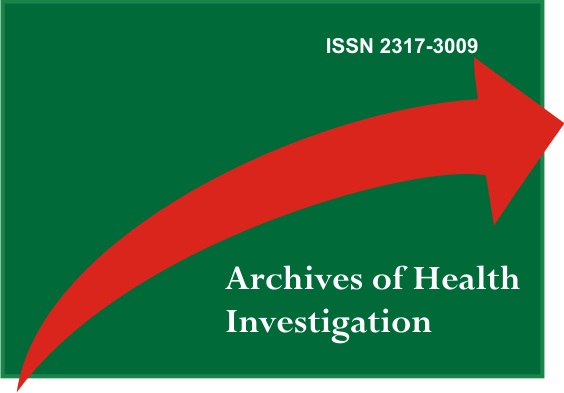Resistance Profile of Bacteria Isolated from Hospitalized Patients with Neoplasm
DOI:
https://doi.org/10.21270/archi.v12i5.6143Keywords:
Neoplasms, Escherichia coli, Cross Infection, Bacterial Infections, Drug ResistanceAbstract
Introduction: Cancer treatment is usually aggressive to the patient's body, and may lead to a possible hospitalization, and it is in this environment that the patient becomes susceptible to developing infectious processes, especially by multidrug-resistant bacteria. Objective: To verify the resistance profile of bacteria isolated from hospitalized patients with cancer. Material and methods: Observational, descriptive and cross-sectional study conducted through the analysis of urine culture reports of oncology patients obtained through a clinical analysis laboratory of a public hospital in the interior of Pernambuco, in the period from February to June 2021. Results: A total of 34 (36.95%) of the urine cultures showed bacterial growth, the most prevalent being Escherichia coli (44.11%), followed by Citrobacter ssp. (26.47%), Enterobacter ssp. (5.88%), Enterococcus ssp. (5.88%), Staphylococcus aureus (5.88%), Staphylococcus coagulase negative (5.88%) and Proteus vulgaris (5.88%). The resistance profile corresponded to nalidixic acid (70.58%), ciprofloxacin (52.94%), cephalothin (52.94%) and sulfametaxozole and trimetropin (50%), while the sensitivity profile was higher for the following antimicrobials: ertapenem, imipenem, piperacycline and tazobactam, each corresponding to 97.06% sensitivity. Conclusions: A greater presence of Gram-negative bacteria was verified, especially Escherichia coli, in addition, the prevalence of bacterial resistance equal to or greater than 50% to antimicrobials of the quinolone (nalidixic acid and ciprofloxacin), cephalosporin (cephalothin) and sulfonamides (sulfametaxozole and trimetropin) classes was also evidenced.
Downloads
References
Santos SLF, Alves HHS, Pessoa CV, Saraiva HSTT, Barros KBNT. Evidências do cuidado farmacêutico na prática clínica da oncologia. Revista da Faculdade de Ciências Médicas de Sorocaba. 2018;20(2):77-81.
Instituto Nacional de Câncer (Brasil). Estimativa 2023 : incidência de câncer no Brasil / Instituto Nacional de Câncer. – Rio de Janeiro : INCA, 2022. Disponível em: https://www.inca.gov.br/sites/ufu.sti.inca.local/files/media/document/estimativa-2023.pdf. Acesso em: 02 de abril de 2023.
Rolston KV. Infections in Cancer Patients with Solid Tumors: A Review. Infect Dis Ther. 2017;6(1):69-83.
Rapoport BL, Cooksley T, Johnson DB, Anderson R, Shannon VR. Treatment of infections in cancer patients: an update from the neutropenia, infection and myelosuppression study group of the Multinational Association for Supportive Care in Cancer (MASCC). Expert Rev Clin Pharmacol. 2021;14(3):295-313.
Dunne MW, Puttagunta S, Aronin SI, Brossette S, Murray J, Gupta V. Impact of Empirical Antibiotic Therapy on Outcomes of Outpatient Urinary Tract Infection Due to Nonsusceptible Enterobacterales. Microbiol Spectr. 2022;10(1):e0235921.
Mason CY, Sobti A, Goodman AL. Staphylococcus aureus bacteriuria: implications and management. JAC Antimicrob Resist. 2023;5(1):123.
Santos SLV, Sousab TK, Costa DM, Lopes LKO, Pelejad EB. Sousa DM, Palosa MAP, Pereira MS. Infecções Associadas ao Cuidado em Saúde em um Hospital Oncológico Brasileiro: análise de cinco anos. 2012;(5):18-26.
Amin CE, Santos DP, Linhaus FK, Freitas IM, Rodrigues JS, Paulo MSL. Determinant factors in hospital infection with carbapenemic resistant klebsiella pneumoniae. Brazilian Journal of Health Review. 2020; 3:14320-14333.
McCarter YS, Burd EM, Hall GS, Zervos M. Cumitech 2C – Laboratory Diagnosis of Urinary Tract Infections. 1ª ed. Washington, USA: ASM Press; 2009.
Koneman EW, Allen SD, Janda WM, Schreckenberger PC, Winn Junior WC. Diagnóstico Microbiológico. Texto e Atlas Colorido. 6 ed. Rio de Janeiro: Guanabara Koogan, 2016. 1760p.
BRAZILIAN COMMITTEE ON ANTIMICROBIAL SUSCEPTIBILITY TESTING - BrCAST. Tabela-pontos-de-corte-clinicos-BrCAST, v. 1, mar. 2021. Disponível em: http://brcast.org.br/documentos/. Acessado em 25 de abril de 2023.
Leite MIM, Silv CF, Colombo A, Naue CR. Prevalência e perfil de sensibilidade antimicrobiana de bactérias isoladas de pacientes internados em Unidade de Terapia Intensiva de um hospital universitário do Sertão de Pernambuco. Semina: Ciências Biológicas e da Saúde.2021; 42(1), 15-28.
Xavier LAL,Gouveia FL, Siqueira ABS, Santana DL, Albuquerque IKP, Macêdo DPCM. Perfil de resistência microbiana em uroculturas de pacientes internados em hospital militar de Pernambuco.The Brazilian Journal of Infectious Diseases. 2022; 26(1).
Gonçalves GR, Silva KS, Lima RS, Silva CF, Aquino SR, Naue CR. Perfil bacteriano de uroculturas coletadas em pacientes internados na UTI de um Hospital Universitário de Pernambuco. Revista de Ensino, Ciência e Inovação em Saúde. 2020;1(1):67-76.
Xavier ATF, Ataíde MBC, Pereira FGF, Nascimento VS. Análise de gênero para o adoecer de câncer. Revista Brasileira de Enfermagem. 2010;63(60); 921-926.
Martins AM, Gazzinelli AP, Almeida SSL, Modena CM. Concepções de psicólogos sobre o adoecimento de homens com câncer. Psicologia: Teoria e Prática. 2012;14(2):74-87.
Sime WT, Biazin H, Zeleke TA, Desalegn Z. Urinary tract infection in cancer patients and antimicrobial susceptibility of isolates in Tikur Anbessa Specialized Hospital, Addis Ababa, Ethiopia. PLoS One. 2020;15(12):e0243474.
Parikh P, Bhat V. Urinary tract infection in cancer patients in a tertiary cancer setting in India: microbial spectrum and antibiotic susceptibility pattern. Antimicrob Resist Infect Control. 2015;4(Suppl 1):P221.
Shrestha G, Wei X, Hann K, Soe KT, Satyanarayana S, Siwakoti B, Bastakoti S, Mulmi R, Rana K, Lamichhane N. Bacterial Profile and Antibiotic Resistance among Cancer Patients with Urinary Tract Infection in a National Tertiary Cancer Hospital of Nepal. Trop Med Infect Dis. 2021 Apr 13;6(2):49.
Chen YW, Teng CH, Ho YH, Jessica Ho TY, Huang WC, Hashimoto M, Chiang IY, Chen CS. Identification of bacterial factors involved in type 1 fimbria expression using an Escherichia coli K12 proteome chip. Mol Cell Proteomics. 2014;13(6):1485-94.
Hooper DC, Jacoby GA. Mechanisms of drug resistance: quinolone resistance. Ann N Y Acad Sci. 2015;1354(1):12-31.
Shaikh S, Fatima J, Shakil S, Rizvi SM, Kamal MA. Antibiotic resistance and extended spectrum beta-lactamases: Types, epidemiology and treatment. Saudi J Biol Sci. 2015;22(1):90-101.
Wang N, Yang X, Jiao S, Zhang J, Ye B, Gao S. Sulfonamide-resistant bacteria and their resistance genes in soils fertilized with manures from Jiangsu Province, Southeastern China. PLoS One. 2014;9(11):e112626.


